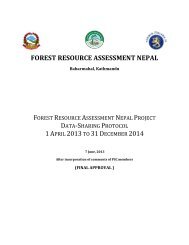Download - FRA Nepal
Download - FRA Nepal
Download - FRA Nepal
Create successful ePaper yourself
Turn your PDF publications into a flip-book with our unique Google optimized e-Paper software.
National Forestry forest management<br />
sector<br />
decisions<br />
are strengthened<br />
Strategic forest decisions are are<br />
made<br />
with accurate data<br />
More accurate forest<br />
decision making<br />
data are available continuously<br />
Sound co co - operation and<br />
data links between<br />
organizations and and well well<br />
organized data dissemination<br />
Actual,<br />
integrated natural<br />
resource data available<br />
Strong data processing<br />
capacity and capability<br />
Data sharing<br />
standard procedures<br />
applied and<br />
knowhow of different<br />
departments utilized<br />
efficiently. Benefits<br />
of decentralization<br />
Applied in data<br />
Collection.<br />
Data<br />
dissemination<br />
well organized<br />
trough<br />
partnerships,<br />
Trained<br />
End-Users<br />
New Sampling<br />
systems created,<br />
and biometric<br />
models<br />
available to to<br />
provide Carbon<br />
and Growth<br />
Data.<br />
New efficient<br />
monitoring<br />
System running.<br />
Accurate<br />
remote sensing<br />
data exist<br />
for frequent<br />
monitoring<br />
Links to<br />
census,<br />
wildlife,<br />
agri-statistics,<br />
industrial<br />
statistics<br />
exists<br />
Knowledge and<br />
skills improved<br />
in remote sensing<br />
and biometric<br />
Modeling .<br />
Strong<br />
computer<br />
and data<br />
management<br />
skills at all<br />
levels.<br />
Figure 2. Objective Tree for national forest information management<br />
The tree shows the objectives required to resolve the core problem. The primary objectives of the project are identified as<br />
follows:<br />
Objective 1.The first objective is to establish well-functioning co-operation and open data sharing system between<br />
organizations.<br />
Data sharing responsibilities and data collection mechanisms will be negotiated and agreed between organizations. The<br />
decentralization of project activities and outsourcing will be the key strategies to collect the data. For the purpose of data<br />
sharing, the policy and protocol will be formulated. The standards for data transfer and delivery practices will be developed.<br />
Objective 2.The second objective is generating of integrated natural resource data.<br />
To achieve the stipulated objective data need assessment will be carried out. Project will design the statistically and<br />
technologically sound inventory methods.<br />
Objective 3.The third objective is to enhance the data processing capacity of the DFRS.<br />
Advance training course will be designed in RS and GIS. The lowest level objectives in the objective tree are like activities,<br />
which will be the guideline to make a plan during <strong>FRA</strong> project implementation.<br />
Relevancy of the project<br />
<strong>Nepal</strong> is undergoing political, social and economic restructuring processes. The end of the conflict and successful elections of<br />
Constitutional Assembly create new opportunity for moving the country toward positive direction. In this situation, forestry<br />
sector policy and institutions will be transformed to adopt the change. The time period of MPFS 1989 will expire in June<br />
2010. Many internationally supported activities such as UNFCCC and REDD mechanism are highlighted. In this context up<br />
dated forest data are required, which are absent at the moment. The project aims to produce national level baseline<br />
information and establish a system to keep the data updated. As such the project is highly relevant.<br />
Impact of the project<br />
Forest resources are used in combination with other natural assets to sustain livelihoods. However, sustainable livelihood can<br />
only be achieved, when the resources are used and managed in sustainable way. Flexibility of income from forest/tree<br />
products is a positive feature for the rural poor. Because any significant reduction in the local forest and tree capital affects<br />
primarily the poorest sections of the population, it is essential to monitor these resources and allocate actions for forest-based<br />
poverty reduction activities.<br />
13





